The NVIDIA GeForce RTX 2080 Super Review: Memories of the Future
by Ryan Smith on July 23, 2019 9:00 AM EST- Posted in
- GPUs
- GeForce
- NVIDIA
- Turing
- GeForce RTX
Power, Temperatures, & Noise
Last, but not least of course, is our look at power, temperatures, and noise levels. While a high performing card is good in its own right, an excellent card can deliver great performance while also keeping power consumption and the resulting noise levels in check.
| GeForce Video Card Voltages | |||||
| RTX 2080S Boost | RTX 2080S Idle | RTX 2080 Boost | RTX 2070S Boost | ||
| 1.05v | 0.65v | 1.05v | 1.043v | ||
Overall, the voltages being used for the RTX 2080 Super are not any different than NVIDIA’s other TU104 cards – or any of their other Turing cards, for that matter. At its highest clockspeeds the card runs at 1.05v, quickly stepping down to below 1v at lower clockspeeds. The 0.65v idle voltage is among the lowest we’ve ever recorded for an NVIDIA card, however.
| GeForce Video Card Average Clockspeeds | |||||
| Game | RTX 2080S | RTX 2080 Ti | RTX 2080 | RTX 2070S | |
| Max Boost Clock | 1965MHz | 1950MHz | 1900MHz | 1950MHz | |
| Boost Clock | 1815MHz | 1545MHz | 1710MHz | 1770MHz | |
| Tomb Raider | 1937MHz | 1725MHz | 1785MHz | 1875MHz | |
| F1 2019 | 1920MHz | 1725MHz | 1785MHz | 1875MHz | |
| Assassin's Creed | 1920MHz | 1800MHz | 1815MHz | 1890MHz | |
| Metro Exodus | 1937MHz | 1755MHz | 1785MHz | 1875MHz | |
| Strange Brigade | 1920MHz | 1695MHz | 1770MHz | 1875MHz | |
| Total War: TK | 1937MHz | 1740MHz | 1785MHz | 1875MHz | |
| The Division 2 | 1937MHz | 1635MHz | 1740MHz | 1845MHz | |
| Grand Theft Auto V | 1937MHz | 1815MHz | 1815MHz | 1890MHz | |
| Forza Horizon 4 | 1937MHz | 1815MHz | 1800MHz | 1890MHz | |
Looking at clockspeeds, we can piece together a couple of interesting pieces of information. On the clockspeed side, NVIDIA hasn’t actually changed the card’s maximum clockspeed all that much. Our RTX topped out at 1900MHz, and the RTX 2080 Super is only a bit higher at 1965MHz. That they’re doing it without more voltage is a bit more interesting – it looks like chip quality may have improved a bit over the past year – but not too surprising.
What is more surprising however are the average clockspeeds we recorded for the RTX 2080 Super. In short, the card spends a lot of time at or near its top turbo bins. With temperature compensation active, our RTX 2080 Super tops out at 1937MHz; a clockspeed that it holds at for over half of our games even at 4K. Quite frankly the RTX 2080 Super is almost a boring card in this respect (in a good way); there’s just not much in the way of power throttling going on here. If anything, the hard part is getting the card above 90-95% power usage.
This, ultimately, is why the RTX 2080 Super is as fast as it is versus the vanilla RTX 2080. The extra SMs help, but it’s the extra 100-150MHz on the GPU clockspeed that’s really driving the card.
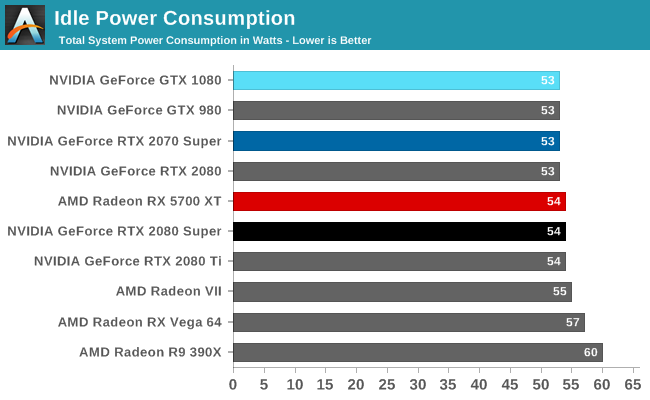
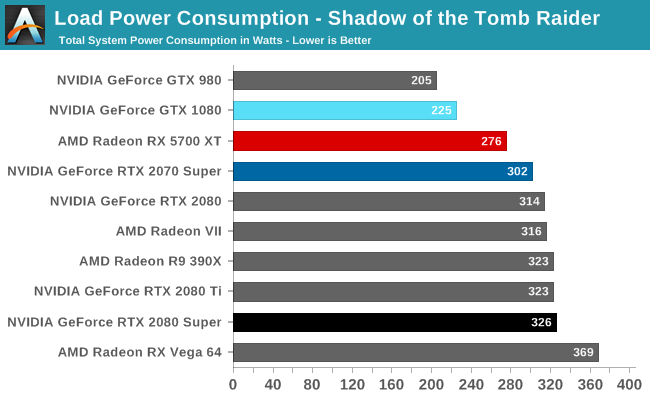
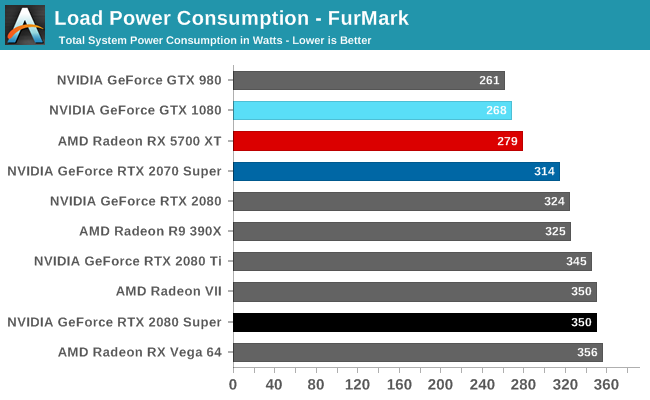
Getting to power consumption itself then, idle is effectively unchanged, exactly as we’d expect it. Load power, on the other hand, is paying the price for those 1900MHz+ clockspeeds. Under both FurMark and Tomb Raider, our RTX 2080 Super-equipped system is drawing almost the same amount of power as the RTX 2080 Ti system with a difference of just a few watts. That performance doesn’t come for free. NVIDIA’s overall power efficiency is still quite good here (the Radeon VII won’t be touching it, for example), but it’s clearly regressed a bit versus the RTX 2080 Ti and vanilla RTX 2080.
It is worth noting, however, that often the card was clockspeed-limited rather than power limited. So while Tomb Raider was specifically picked to be a punishing game – a task it delivered on here – I fully expect that the RTX 2080 Super is drawing a bit less than the RTX 2080 Ti in around half of our other games.
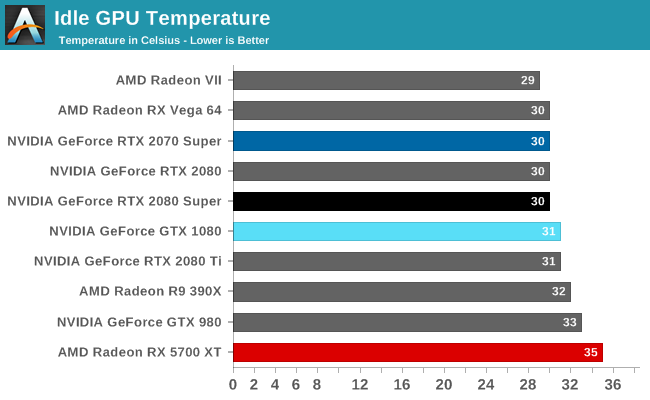
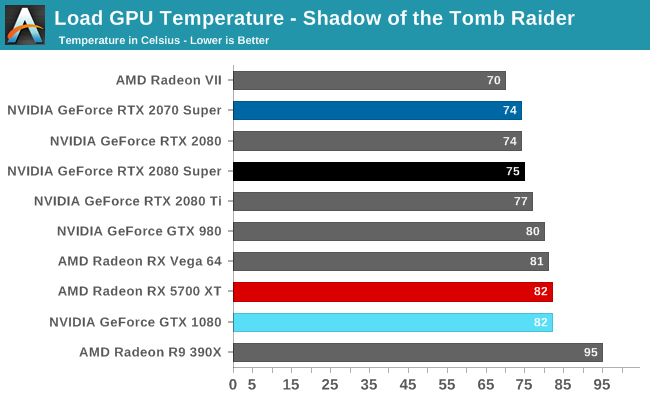

With higher power consumption and the same cooler comes higher temperatures. Even FurMark’s 77C is still several degrees below the card’s 84C thermal throttle point, but it is a very straightforward consequence of the increased power consumption.
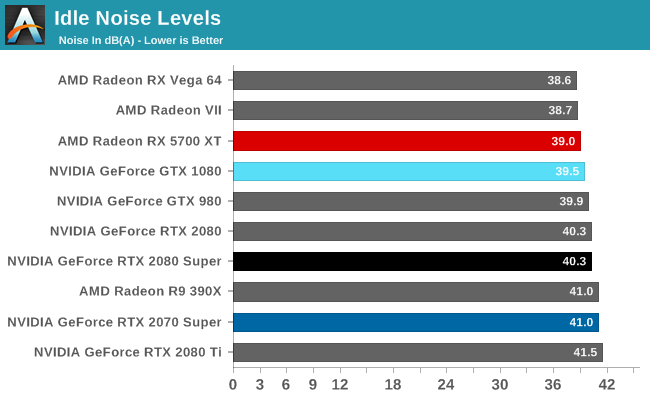
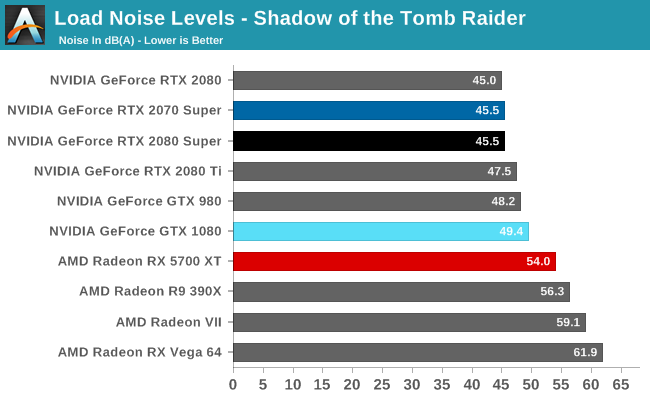
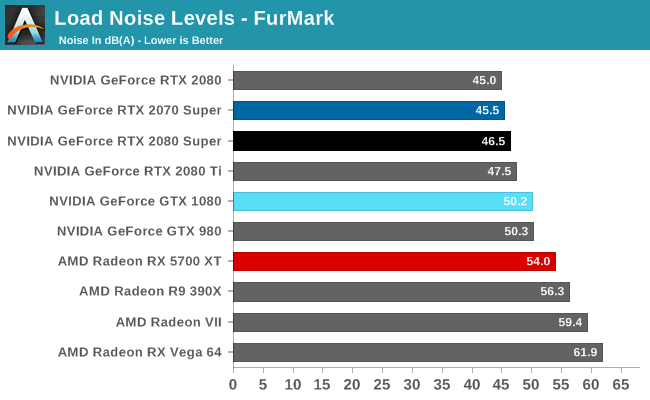
Last, but not least, we have noise. Again this is the same cooler as the RTX 2080 & RTX 2080 Ti, so the card has to work a bit harder to keep itself cool versus the original RTX 2080. The net result is that the RTX 2080 Super splits the difference between the original RTX 2080 and the RTX 2080 Ti, peaking at 46.5 dB(A). This is unlikely to be a very noticeable change as compared to the RTX 2080, but it’s louder none the less. I’m actually a bit surprised it didn’t pull even with the RTX 2080 Ti, but then our RTX 2080 Ti seems to run just a bit loud period – even at idle it’s a bit louder.










111 Comments
View All Comments
yetanotherhuman - Wednesday, July 24, 2019 - link
A real shame the 1080 Ti isn't in the benchmarking graphs, it's clearly the competitor card to the 2080 and 2080 Super. It would show just how little NVIDIA has done in giving us better performance to price in just over 2 yearsDanNeely - Wednesday, July 24, 2019 - link
It needs retested first. Look at Bench, it's not in the 2019 GPU bench yet; hopefully this is just a case of not gotten to it yet (2019 GPU bench is still fairly sparse vs 2018) and not a case of the card being assigned to someone other than Ryan and thus not being available for him to cycle through the GPU benchmark box.imaheadcase - Wednesday, July 24, 2019 - link
Its really weird you never include the 1080 Ti in the benchmarks.bill.rookard - Wednesday, July 24, 2019 - link
The 5700XT certainly is a spoiler of sorts, 80-90% of the performance for a little more than half the price.Ranger90125 - Thursday, July 25, 2019 - link
Good review...thanks. I'm assuming that the most important aspect of the Super cards i.e. the ray tracing perf, is very similar going from RTX2080 TO RTX2080 Super? ;)Kishoreshack - Thursday, July 25, 2019 - link
How do I donate to Anandtech for writing such excellent articles?bajs11 - Friday, July 26, 2019 - link
single digit improvement while still being overpriced as the original 2080Where I live the original 2080 still cost over 700 usd while the super are about 150 bucks more...
maybe they are a lot cheaper in the states
ballsystemlord - Saturday, July 27, 2019 - link
Spelling and grammar corrections so far:"However it's still requires more power than the RTX 2080 vanilla, ..."
Excess "s":
"However it still requires more power than the RTX 2080 vanilla, ..."
"...which its much better performance-per-dollar ratio."
"With", not "which":
"...with its much better performance-per-dollar ratio."
Beaver M. - Saturday, July 27, 2019 - link
So Nvidia now thinks 8 GB is enough from 2060S through 2080S? Sure sure.But I guess there are still enough victims who will buy this overpriced and not future proof crap.
DillholeMcRib - Sunday, July 28, 2019 - link
I have no idea why anyone would pay the Nvidia tax with the Radeon Navi stuff out.Right now I am using the 5700 XT and while it is a little loud, it matches up really well with the 2070 Super for $100 less. RTX specific stuff is virtually non existent.